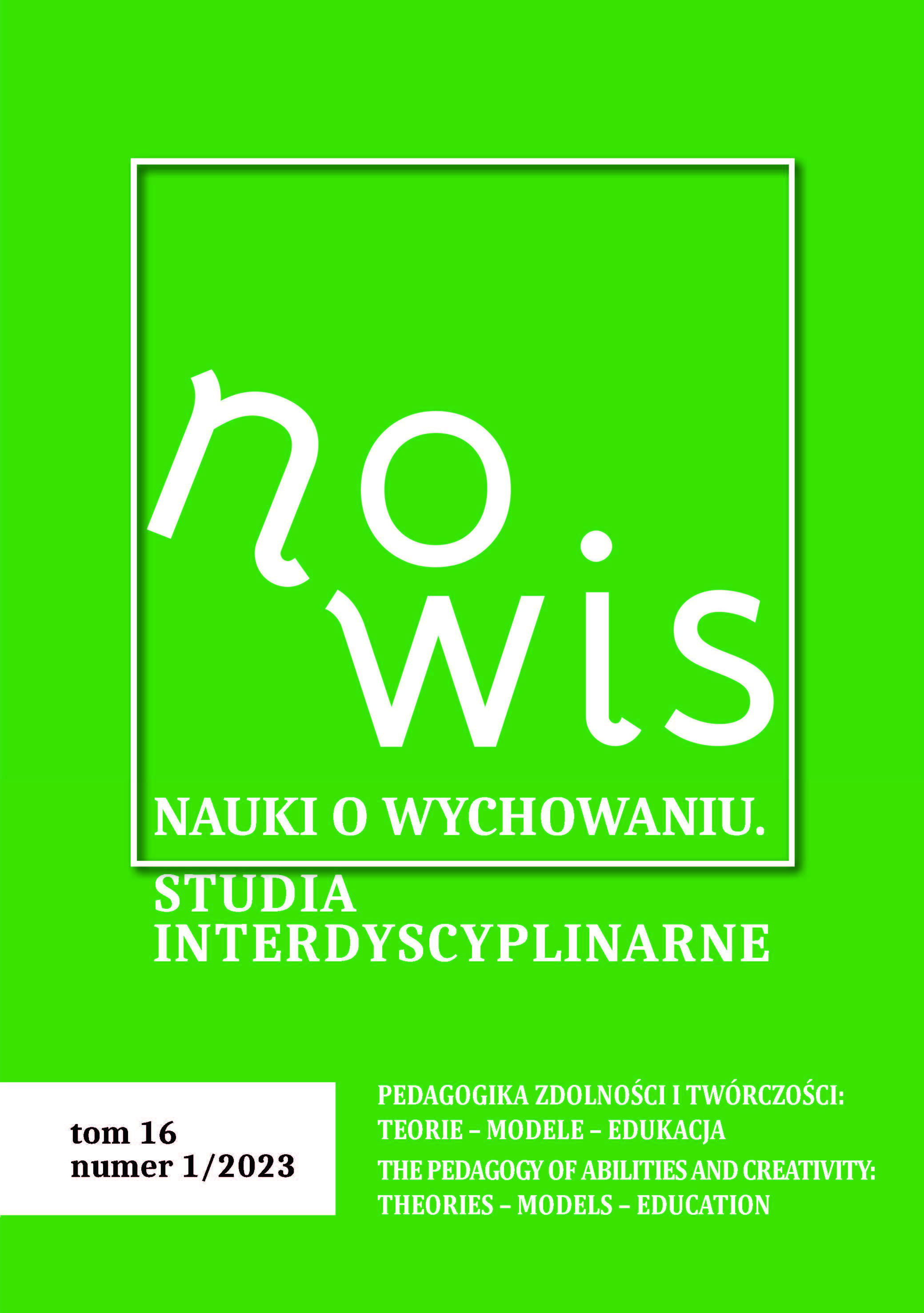Wydostać się z cienia ograniczeń ciała i umysłu – zespół sawanta w optyce twórców filmowych
DOI:
https://doi.org/10.18778/2450-4491.16.17Słowa kluczowe:
zespół sawanta, uzdolnienia specjalne, biografia filmowaAbstrakt
Głównym celem artykułu jest przedstawienie dwóch sylwetek sawantów, będących z jednej strony osobistościami świata nauki, a z drugiej osobami borykającymi się z zaburzeniami neurorozwojowymi i schizofrenią. Są to postaci Temple Grandin i Johna Nasha. Stały się one również inspiracją dla twórców dwóch filmów fabularnych, które weszły już do kanonu kinematografii, były też wielokrotnie nagradzane, także za kreacje protagonistów, doskonale portretując nie-neurotypowych geniuszy. Hermeneutyczna analiza tych obrazów kinowych ma na celu ukazanie specyfiki funkcjonowania prodigious savant ze zwróceniem szczególnej uwagi na rolę najbliższego otoczenia w budowaniu sprzyjających warunków dla rozwoju ich szczególnych talentów.
Bibliografia
Andreasen N. A. (2015) John and Alice Nash: A Beautiful Love Story, „The American Journal of Psychiatry”, nr 8(172), s. 710–713, https://doi.org/10.1176/appi.ajp.2015.15060709
Google Scholar
DOI: https://doi.org/10.1176/appi.ajp.2015.15060709
Barks C. (2016) Rumi’s Little Books of Love and Laughter: Teaching Stories and Fables, Newburyport, MA, Hampton Roads Publishing.
Google Scholar
Chi R. P., Snyder A. W. (2011) Facilitate Insight by Non-Invasive Brain Stimulation, „PLoS ONE”, nr 6(2), s. 1–7, https://doi.org//10.1371/journal.pone.0016655
Google Scholar
DOI: https://doi.org/10.1371/journal.pone.0016655
Clare C. (2017) Lord of Shadows, New York, Simon and Schuster.
Google Scholar
Eastwood S., Evans B., Gaigg S., Harbord J., Milton D. (2022) Autism Through Cinema: Co-Creation and the Unmaking of Knowledge, „International Journal of Qualitative Studies in Education”, Ahead of Print, https://doi.org/10.1080/09518398.2022.2025492
Google Scholar
DOI: https://doi.org/10.1080/09518398.2022.2025492
Garret M., Ezzo M. (1996) Edutainment. The Challenge, „Journal of Interactive Instruction Development”, nr 3(8), s. 3–7.
Google Scholar
Grandin T. (1995) Thinking in Pictures. My Life with Autism, New York, Doubleday, Bantam Doubleday Dell Publishing.
Google Scholar
Grandin T., Duffy Kate (2004) Developing Talents: Careers for Individuals with Asperger Syndrome and Highfunctioning, Minnetonka, Autism Asperger Publishing Company.
Google Scholar
Grandin T., Johnson C. (2005) Animals in Translation: Using the Mysteries of Autism to Decode Animal Behavior, London, Bloomsbury Publishing.
Google Scholar
Gyarmathy É. (2018) The Savant Syndrome and Its Connection to Talent Development, „Open Science Journal of Psychology”, nr 2(5), s. 9–16.
Google Scholar
Hughes J. E. A., Ward J., Gruffydd E., Baron-Cohen S., Smith P., Allison C., Simner J. (2018) Savant Syndrome Has a Distinct Psychological Profile in Autism, „Molecular Autism”, nr 9, s. 53, https://doi.org/10.1186/s13229-018-0237-1
Google Scholar
DOI: https://doi.org/10.1186/s13229-018-0237-1
Kéri S. (2009) Genes for Psychosis and Creativity: A Promoter Polymorphism of the Neuregulin 1 Gene Is Related to Creativity in People With High Intellectual Achievement, „Psychological Science”, nr 20(9), s. 1070–1073, https://doi.org/10.1111/j.1467-9280.2009.02398.x
Google Scholar
DOI: https://doi.org/10.1111/j.1467-9280.2009.02398.x
Krasoń K. (2020) Padawanika. Przebudzenie mocy w doświadczeniu zapośredniczonym. Studium o filmie, wychowaniu i wsparciu rozwoju, Katowice, Wydawnictwo Uniwersytetu Śląskiego.
Google Scholar
Nasar S. (1998) A Beautiful Mind, New York, Simon & Schuster.
Google Scholar
Schipperheijn J. A. M., Dunne F. J. (1990) The Savant Syndrome Genius and Mental Handicap Combined, „Psychiatric Bulletin”, nr 14, s. 475–476, https://doi.org/10.1192/pb.14.8.475
Google Scholar
DOI: https://doi.org/10.1192/pb.14.8.475
Snyder A. W., Mulcahy E., Taylor J. L., Mitchell D. J., Sachdev P., Gandevia S. C. (2003) Savant- Like Skills Exposed in Normal People by Suppressing the Left Fronto-Temporal Lobe, „Journal of Integrative Neuroscience”, vol. 2, nr 2, s. 149–158, https://doi.org/10.1142/s0219635203000287
Google Scholar
DOI: https://doi.org/10.1142/S0219635203000287
Treffert D. A. (2009) The Savant Syndrome: An Extraordinary Condition. A Synopsis: Past, Present, Future, „Philosophical Transactions of The Royal Society B – Biological Sciences”, nr 1522(364), s. 1351–1357, https://doi.org/10.1098/rstb.2008.0326
Google Scholar
DOI: https://doi.org/10.1098/rstb.2008.0326
Treffert D. A. (2014) Savant Syndrome: Realities, Myths and Misconceptions, „Journal of Autism and Developmental Disorders”, nr 44, s. 564–571, https://doi.org/10.1007/s10803-013-1906-8
Google Scholar
DOI: https://doi.org/10.1007/s10803-013-1906-8
Wojtyniak J. (2015) Edutainment i edukacja filmowa jako narzędzia kształtowania tożsamości oraz postaw dzieci i młodzieży, „Państwo i Społeczeństwo”, nr 1, s. 170.
Google Scholar
DeGroot D. (2020) Dr. Temple Grandin of CSU Named One of the Top College Professors in the Country, [online:] https://ourcommunitynow.com/news-local/dr-temple-grandin-of-csu-named-one-of-the-top-college-professors-in-the-country (dostęp: 1.11.2022).
Google Scholar
Grandin T. (2014) Temple Grandin Askwith Forum: All Kinds of Minds Help the World, [online:] https://www.youtube.com/watch?v=9klKhlc_cJg (dostęp: 30.10.2022).
Google Scholar
Grandin T. (2016) Educating Students Who Have Different Kinds of Minds, [online:] https://www.youtube.com/watch?v=8LCrjUL8qU4&t=629s (dostęp: 30.10.2022).
Google Scholar
John F. Nash Jr. – Facts, [online:] https://www.nobelprize.org/prizes/economic-sciences/1994/nash/facts/ (dostęp: 30.10.2022).
Google Scholar
Leonard T. (2010) Temple Grandin: My Autism Made Me A Cowgirl Superstar, [online:] https://www.beefmagazine.com/people/0929-temple-grandin-cowgirl-superstar (dostęp: 1.11.2022).
Google Scholar
Meet Kim Peek: The incredible case of the man who could memorize everything (2022/2023), [online:] https://yestherapyhelps.com/meet-kim-peek-the-incredible-case-of-the-man-who-could-memorize-everything-10280 (dostęp: 31.10.2022).
Google Scholar
Nutt A. E. (2015) Alicia Nash, wife of Nobel Laureate, dies at 82, „The Washington Post”, may 27, [online:] https://www.washingtonpost.com/national/health-science/alicia-nash-wife-of-nobel-laureate-dies-at-82/2015/05/27/6fced406-0479-11e5-bc72-f3e16bf50bb6_story.html (dostęp: 31.11.2022).
Google Scholar
Spektrum autyzmu w filmowej opowieści – wywiad z organizatorami Przeglądu Filmów o Autyzmie i Zespole Aspergera (2019) [online:] https://www.wszpwn.com.pl/wydarzenie/spektrum-autyzmu-w-filmowej-opowiesci-wywiad-z-organizatorami-przegladu-filmow-o-autyzmie-i-zespole-aspergera,459.htSpektrum%20autyzmu%20w%20filmowej%20opowie%C5%9Bci%20-%20wywiad%20z%20organizatorami%20Przegl%C4%85du%20Film%C3%B3w%20o%20Autyzmie%20i%20Zespole%20Aspergera (dostęp: 15.10.2022).
Google Scholar
Temple Grandin, Ph.D., [online:] https://www.templegrandin.com/ (dostęp: 1.10.2022).
Google Scholar
: A Space Odyssey (1968) reż. Stanley Kubrick, Metro-Goldwyn-Mayer, USA – Wielka Brytania.
Google Scholar
A Beautiful Mind (2001) reż. Ron Howard, DreamWorks SKG – Imagine Entertainment – Universal Pictures, USA.
Google Scholar
Extra Life: A Short History of Living Longer (2021) serial dokumentalny, Wielka Brytania – USA, sezon 1, odcinek 3.
Google Scholar
Rain Man (1988) reż. Barry Levinson, United Artist – Guber-Peters Company, USA.
Google Scholar
Temple Grandin (2010) reż. Mick Jackson, HBO Films – Ruby Films, USA.
Google Scholar






 Strona czasopisma, prowadzona przez Zespół redakcyjny NOWiS na platformie Index Copernicus:
Strona czasopisma, prowadzona przez Zespół redakcyjny NOWiS na platformie Index Copernicus: 





